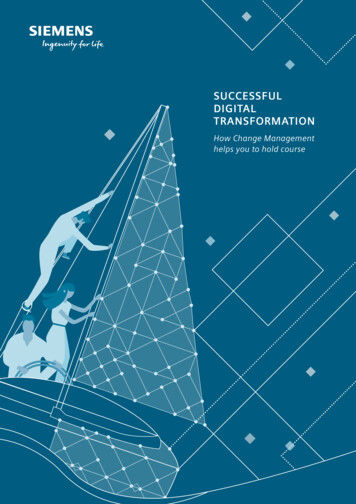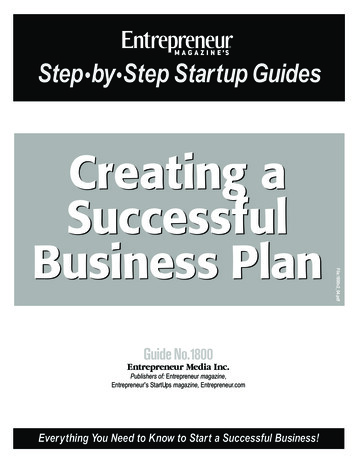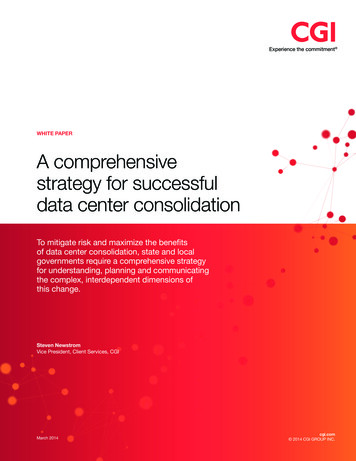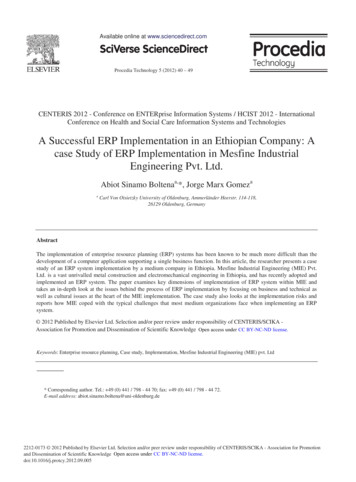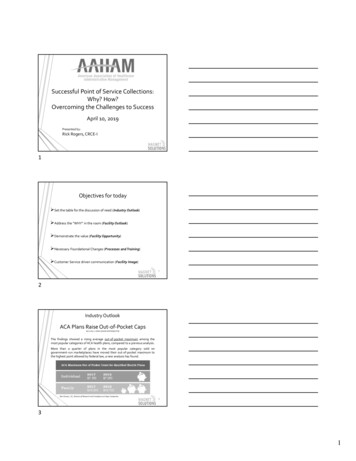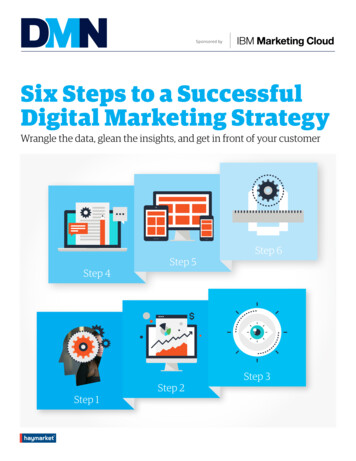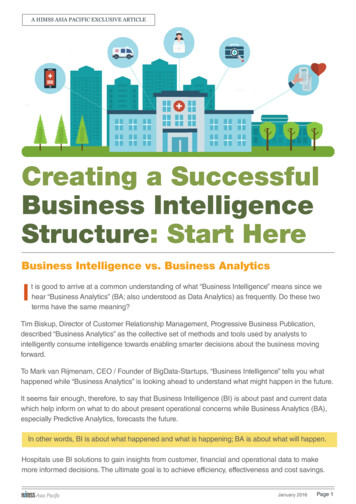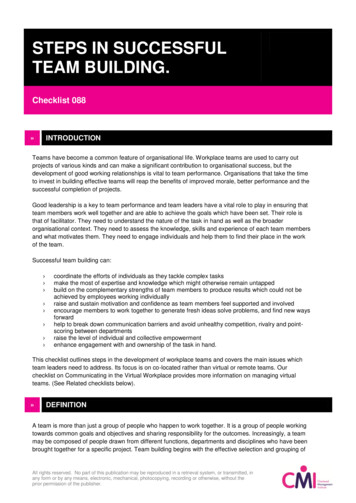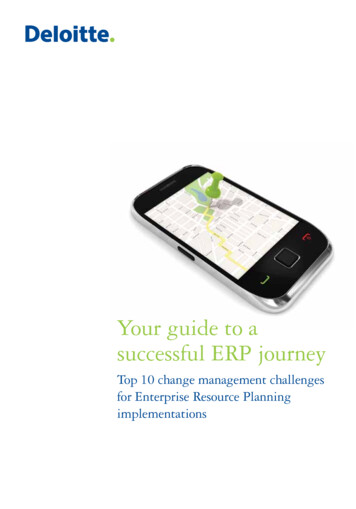
Transcription
Your guide to asuccessful ERP journeyTop 10 change management challengesfor Enterprise Resource Planningimplementations
“The single biggest failure point forERP implementations is the need forchange management.”Neville Turbet, Project PerfectContentsPlan the trip.21 Get everyone on board .32 Make sure someone’s removing roadblocks.43 Check the rear-view mirror.5Hit the road.64 Put the horse before the cart.75 Prepare for detours.86 Ask for directions along the way.97 Teach them to drive the new standard.11It’s a journey, not a destination.128 Stay on the right side of the tracks .139 Use the “GPS” system – get participation swiftly.1410 Missing a turn doesn’t mean the end of the road .15With the price of gas these days.16
Major project failure is an unfortunate fact for many organizations,and Enterprise Resource Planning (ERP) projects are no exception.Analyst firm Gartner estimates that 55% to 75% of all ERP projects failto meet their objectives. Whether your project is a few months or afew years long, whether it’s an upgrade or a new implementation, thefinancial and cultural well-being of the entire organization is at stake,and the associated costs of failure range from disruptive tocatastrophic. You must do everything possible to ensure success.Fortunately, while failure is common, it is not unavoidable. Deloittehas identified the critical people-related challenges organizationstypically face at each phase of an ERP implementation, as well asspecific steps you can take to mitigate them. With so much on theline, consider what your organization can do to minimize risk andmake your ERP project implementation journey as smooth as possible.Your guide to a successful ERP journey1
Planthe tripProject preparationis a make-or-break imperative2Your guide to a successful ERP journey
1Get everyone on boardUnderstand and articulate the need for changeBefore beginning any ERP project, it’s critical to ensure that the entireorganization understands the reasons and strategy behind the move. Ifdecision makers do not clearly support the need for change, your budgetand resource planning may be negatively affected. If project members andend users don’t understand the objectives, confusion can prevail overpurpose and commitment, increasing resistance to change and reducingthe chance of success.To address these challenges Define the need for change by Be clear on the budget and resourcesdeveloping a clear picture of how therequired to support the project, andorganization will benefit from this initiative.determine the resource ramp-up plan so theThis can go a long way to gaining buy-in andproject doesn’t stall at the start. Also, makegenerating enthusiasm for thesure everyone involved understands theimplementation.commitment required from all parties. Thiswill help avoid confusion when competing Articulate and endorse the vision. Spendinitiatives inevitably arise.time upfront communicating why thischange is necessary and what will happen ifyou don’t change. Leaders, particularly inareas likely to be affected, need to cascadethis message down to staff.Your guide to a successful ERP journey3
2Make sure someone’s removingroadblocksAdequate sponsorship and leadership are critical to successMany issues raise stumbling blocks over the course of an ERP initiative, so besure you begin on solid footing. To garner the necessary support, andmotivate project members and end users, the implementation must beviewed as a high priority. Appropriate, authoritative sponsorship must visiblydrive the project from the outset. Without day-one endorsement andguidance from all levels of leadership, your project can be over before itbegins. A lack of clear sponsorship or leadership can also negatively affectthe decision-making process and impede progress. The most important rolethe sponsor and other leaders play in an ERP implementation is helping toremove barriers to success for the project.To ensure adequate sponsorship and leadership Determine and clearly communicate Put on a roadshow presentation forwho the project sponsor is at the start.leaders to ensure they are aware and fullyThis is where the buck stops and the sponsorunderstand the purpose and expectedmust have the authority to removebenefits of the project. They will beroadblocks.important allies on the road ahead – equipthem well. Identify other organizational leaderswho need to support and understand Create leadership alignment plans forthe change. These leaders will be veryidentified leaders, with key actions they canhelpful in removing barriers to success.undertake to visibly support the project.Understanding the political climate allowsInclude incentives as an integral part of thethe implementation team to determine thesponsor’s and leaders’ performance plans,best way to position the project with variousbased on their achievement of objectivesleaders. A guiding coalition that is inrelated to the project.agreement is critical for success. Proactively facilitate cross-functionalsessions with leaders early on to gain ashared understanding of the project, itsobjectives and potential barriers, as well asthe important role leaders will playthroughout.4Your guide to a successful ERP journey
3Check the rear-view mirrorUnderstand established business culture and historicalresponse to changeOften times, an understanding of history facilitates future success. For ERPimplementations, organizations should consider how resulting changes fit inwith – or can be adapted to – the prevailing business culture, as well aswhat success the organization has had with past change-based projects.Understanding cultural alignment and change history, as well as the statusof current competing initiatives, can help appropriately prioritize the projectand strategically design it to succeed. If an organization that has nothandled change well in the past is subjected to substantial further change, itmay result in organization change fatigue, which can lead to a lack ofengagement and project commitment. Also, if the change is notcommunicated in a way that highlights its alignment with the organization’sculture, there will likely be resistance from the outset.To alleviate these risks Determine the priority of initiatives Include a detailed change managementcurrently under way or planned for the nearand communication plan to supportterm. Knowing where the ERPeach phase of the ERP implementation.implementation fits into the organization’sChange management activities such aspriorities is key to getting the resources andchange readiness assessments, whichcommitment required to stay on time and onprovide insight into past history with changebudget.and how ready and willing the organizationis to adopt the changes, can help position Create a dashboard that highlights thethe implementation appropriately with endresources, budget and timeline for eachusers. They can also identify mitigationproject to avoid potential conflicts.tactics to avoid change fatigue.Your guide to a successful ERP journey5
Hitthe roadDesign, build and implementeffective solutions6Your guide to a successful ERP journey
4Put the horse before the cartAppropriately structure the project and clearly establish rolesLack of clarity around structure, activities, roles and responsibilities can resultin confusion and resistance, making project execution extremely difficult.Without a clearly developed and articulated project structure, the projectteam may duplicate efforts or leave key tasks unaddressed as they try tofigure out where they should be and what they are specifically responsiblefor. Inevitably, this causes delays and redundancies before the project gets ingear, raising costs and jeopardizing budgets and schedules.To help your project move forward with organization-wide clarity and understanding Hold a project kick-off session to set and Develop and enforce a clear issue andalign expectations, clarify roles andrisk escalation process to capture, andresponsibilities and allow team members toexpeditiously deal with, all issues and risksbond and have their questions answered.throughout the project.Include the project sponsor to ensurevisibility and involvement from the outset. Highlight integration points betweenproject streams to generate discussion Understand and leverage existingearly on. Initial all-staff meetings shouldinternal structures – such asinclude presentations from each stream oncommunication vehicles and decision-makingwhat they understand their project role tobodies – that can assist throughout thebe, and what they see as key integrationimplementation. These structures create apoints with other streams.sense of familiarity and reduce barriers toengagement. Revisit and reinforce roles andresponsibilities regularly throughout theproject life cycle as they may shift or evolveover time.Your guide to a successful ERP journey7
5Prepare for detoursGet back on track quickly by addressing people impactsand behavioural changesMany changes that come about due to an ERP implementation willsubstantially affect employees. Success depends on how effectively youunderstand and manage the impacts of these changes. To achieve the bestresults, proactively prepare employees and the organization as a whole priorto the ERP implementation. A good grasp of potential change impacts willguide your communications, training and leadership alignment activities andprevent wasting time and effort focusing on the wrong things.To effectively address change impacts Identify key changes to systems, Understand how roles andprocesses and organizational structure.responsibilities will change, andWork with business representatives to fullyincorporate those changes, not only in jobunderstand the resulting impacts, fromdescriptions, but in communications andmultiple perspectives and for each role and/training materials. By providing these beforeor area of the organization. Getting businessthe implementation, you can ensure peopleinput on the magnitude of impacts helps youunderstand how their jobs will be affected.focus your communication and trainingefforts on the right things. Create “role impact guides” so end usersclearly understand how their roles willchange, and reinforce specific benefits.People are much more likely to buy in if youcan answer the “what’s in it for me”question.8Your guide to a successful ERP journey
6Ask for directions along the wayCreate change networks and develop “grass roots”internal supportEnsuring you deliver the right messages – to the right people at the righttime – is necessary to limit and manage resistance to change. To help endusers understand what has to happen and why, develop a formal network ofinfluencers who can support two-way communications (both formal andinformal), facilitate deployment activities and monitor how people in theirareas react to and adopt the changes. Ineffective communication can stemfrom unclear messaging, poor timing or targeting the wrong audience.To develop effective internal change communications Create a change network comprised of Build accountability and ownership withinkey influencers from all of the highly affectedthe change network, giving members a senseareas of the organization, and hold regularof control over change managementmeetings to keep them engaged andactivities in their areas and a vested interestinvolved in project activities. By involvingin the project’s success. Empower thethese members in key decisions andchange network to anticipate and escalateinformation dissemination, you promotepotential issues to the project team to ensureunderstanding and increase visibility forthe development of timely and appropriatechange management activities. Thissolutions. It is critical to allocate dedicatedmulti-directional communication channeltime to this role so it gets appropriategives you a better feel for the organization’sattention.pulse and ensures that accurate informationabout the project reaches end users in atimely manner. Provide monitoring and feedbackmechanisms. Develop an “early warning”system to identify emerging implementationchallenges or pockets of resistance.Your guide to a successful ERP journey9
Of the top 10 barriers to a successfulERP journey, 5 can be addressed bydeveloping and implementing astructured change management program.Deloitte CIO SurveyTop 10 barriers to implementation82%Resistance to change72%Inadequate sponsorship65%Unrealistic expectations54%Poor project management46%Case for change not compelling44%Project team lacking skills44%Scope expansion / uncertainty43%No change management program41%No horizontal process view36%IT perspective not integrated0%10%20%30%40%50%Source: Deloitte Touche Tohmatsu CIO Survey10Your guide to a successful ERP journey60%70%80%90%
7Teach them to drive the new standardAssess learning requirements and develop a tailoredtraining programFor your ERP solution to be accepted and embraced, your people must beprepared for transition – to both new systems and new ways of working.This can be accomplished with a training program that addresses criticalgaps in skills and learning. To build an effective program, however, you mustaccurately and comprehensively assess the knowledge requirements andtraining needs of the organization. The success of an ERP implementation ispartly based on how quickly employees can get up to speed working in theirnew environment. You can implement the best system possible, but ifpeople are unable or unwilling to use it, you
and Enterprise Resource Planning (ERP) projects are no exception. Analyst firm Gartner estimates that 55% to 75% of all ERP projects fail to meet their objectives. Whether your project is a few months or a few years long, whether it’s an upgrade or a new implementation, the financial and cultural well-being of the entire organization is at stake,


